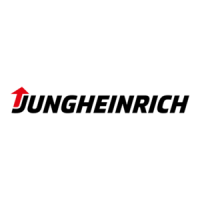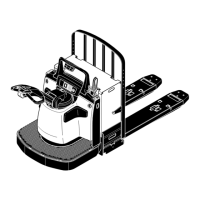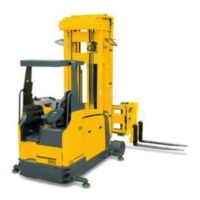Safety clearance (design safety distance)
The racking systems must be set up for the EFX. The safety clearance in the narrow
aisle required by the manufacturer between the following truck components and the
racking system must be observed:
– The safety clearance on both sides between the swivel traverse frame and the
racking and between the racking and the stored goods.
– The safety clearance on both sides between the support arm and the racking and
also the stored goods.
– The safety clearance on both sides between the correctly raised load and the
racking and also the stored goods.
For the safety clearance in the narrow aisle required by the manufacture depending
on the type of guidance in the narrow aisle and the lift height (h
3
) refer to the
following table:
Truck guidance in the narrow
aisle
Lift height (h
3
)
Safety clearance
Wire-guided truck
depending on the lift
height (h
3
)
125 mm
Rail-guided truck
to 4000 mm 90 mm
to 6000 mm 100 mm
from 6000 mm 125 mm
Z
The safety distance may, however, increase if special attachments are fitted.
WARNING!
An insufficient safety distance between the guided truck and the rack can
result in accidents
Failure to maintain the required and prescribed safety distance can result in
collisions between the guided truck and the rack.
u
The maximum travel speeds are reduced if the safety distances required and
prescribed by the manufacturer are not maintained.
u
You must observe the minimum safety distance in accordance with EN 1726-2
item 7.3.2 90 mm. Do not operate the truck in these narrow aisles.
Z
The ground surface must comply with the VDMA guideline.
Guide rails must be provided in the narrow aisles for the rail guidance system.
Vulkollan guide wheels attached to the truck chassis guide the truck between the
guide rails.
A guide wire must be routed in the ground for the wire guidance system. The signals
from the wire are received by sensors on the chassis and processed by the on-board
computer.
Z
The capacity is shown on the data plate.
16
04.19 en-GB

